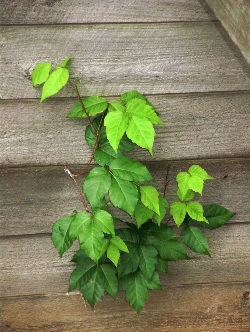ManageSafe
Least-Toxic Control of Poison Ivy Choose a different pests

|
Identification
Pest type: Plants
Poison ivy tolerates some shade but prefers sun. Look for it in tall grass and weedy areas—rarely in regularly mowed turf. In school settings it is most often found along fencelines, along walls, up trees and telephone poles. New growth is reddish.
Poison ivy leaves can grow up to 4–5 inches and are almost always in groups of three. The leaves are generally shiny but can be dull when very mature. Mature plants that have vined can have thick, ropy woody “trunks”. Young plants have soft stems. The leaves can also vary as they are generally not toothed—but they can be toothed and even lobed. The key to identification is the three leafed growth.
Is it a problem?
While poison ivy can pose a health risk to humans, it is important to keep in mind that it is still part of the wider ecosystem. Birds eat the berries of the plant, while deer, insects and other wildlife munch on the leaves. If there is poison ivy in an area where no humans will come in contact with it, it can be left alone.
Pest prevention practices
Non-chemical and mechanical controls
Handpick and destroy
Management of poison ivy depends on the size of the infestation and how much property you have (or where the infestation is located if it’s not your property). If you have a small yard and the poison ivy is still relatively young, you can get rid of it through consistent mowing and cutting down the young shoots until the plant dies, and by digging up the roots. If it is growing as a vine on a tree or fence, you can cut it at the base and pull it out from there. Of course, special precautions should be taken, such as wearing protective gloves and clothing, and washing them immediately after.
The easiest way to pull out ivy, as with any plant, is to either wait until after a heavy rain or water the area yourself, because the moisture loosens the soil, making it easier to pull out roots. However, be careful not to touch anything else after you have come in contact with the plant —it’s very helpful to have another person around who can assist you.
This may seem like a lot of work, however it is important to note that the use of toxic chemicals such as glyphosate and triclopyr can be just as time consuming, since it often requires multiple treatments and you will still need to cut down the plant in order to prevent exposure. Since you will have to wear protective clothing anyway, you might as well just pull out the roots instead of risking exposure to both the pesticide and the plant’s toxicant.
Biological controls
For a particularly large infestation, or for publicly owned land, you might consider the use of goats. Cities all across the country are hiring goats for weed control, including the city of Carrboro, NC. The city successfully controlled a poison ivy infestation in a town dog park through the use of a targeted goat grazing service. In addition to eating weeds like poison ivy, goats add fertilizer and aerate the soil with their hooves, all at the same time. Read about North Carolina’s success on our Daily News Blog.
For more information on managing land with goats, check out this talk from our board member Lani Malmberg, professional “gypsy” goat herder.
Least-toxic chemical options as a last resort
If the plant breaks and some of the root is still in the soil and you are unable to get it out, you can use a horticultural vinegar spray or a horticultural soap.
Social Media
See what other folks are saying about this, and let us know what works for you.
Welcome back to Question of the Week!It’s still warm enough for your kids to be playing outside, and many parents...
Posted by Beyond Pesticides on Friday, September 4, 2015
Click the post above to view and comment on Facebook, or comment directly on this site below.








